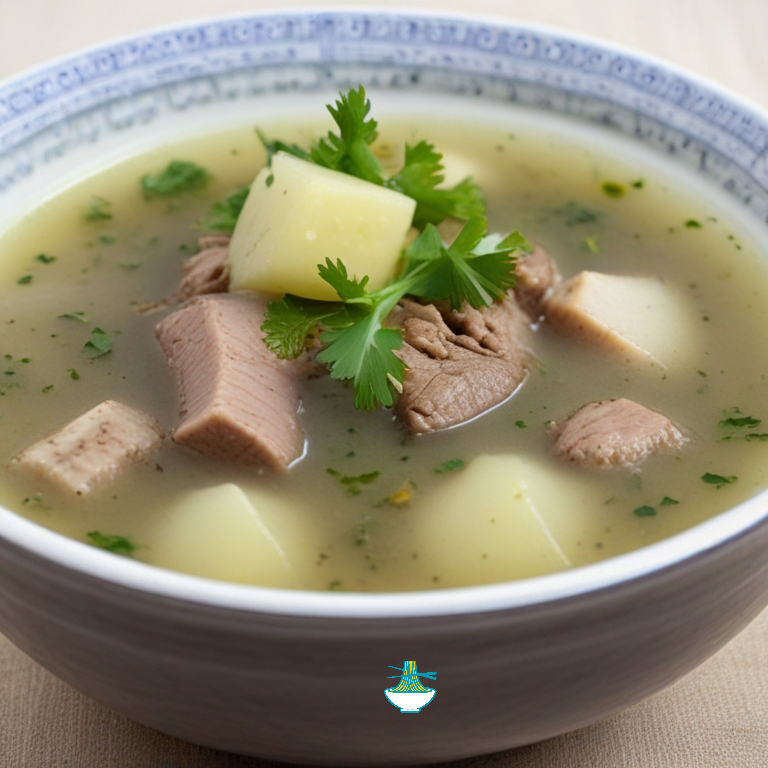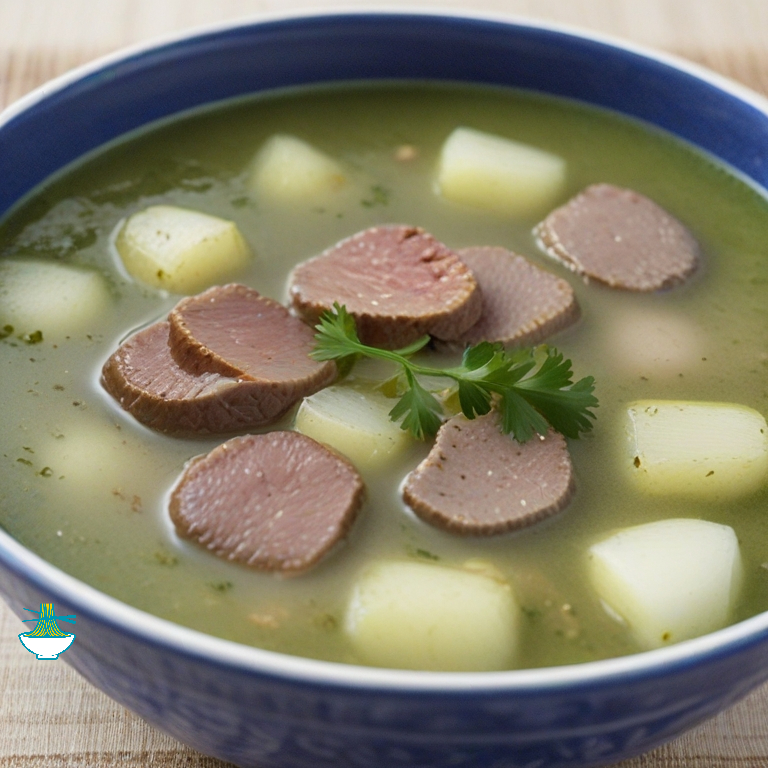Embark on a culinary journey to the Arctic with Greenland's iconic dish, Suaasat. Translating to "soups" in Greenlandic, Suaasat embodies the rich cultural heritage and unique flavors of Greenland. This hearty stew, traditionally made with seal, whale, or reindeer meat, reflects the resourcefulness and resilience of the indigenous Inuit people who have thrived in Greenland's challenging environment for centuries.
Join us as we explore the origins, ingredients, and preparation methods behind this beloved dish, passed down through generations. From the tender chunks of meat to the earthy undertones of root vegetables and aromatic herbs, every spoonful of Suaasat tells a story of survival and adaptation in one of the world's most remote regions.
Discover the significance of Suaasat in Greenlandic culture, where it serves not only as a nourishing meal but also as a symbol of community and connection. Whether enjoyed during festive gatherings, family celebrations, or simply as a comforting meal on a cold winter's night, Suaasat captures the essence of Greenland's culinary identity, inviting you to experience the warmth and hospitality of the Arctic firsthand.
Here's a traditional recipe for Greenland Suaasat:
Ingredients:
- 500g of seal, whale, or reindeer meat (you can also use beef or lamb as alternatives)
- 3-4 medium potatoes, peeled and diced
- 1 large onion, finely chopped
- 2-3 carrots, peeled and sliced
- 2-3 celery stalks, chopped
- 2-3 cloves of garlic, minced
- 1 bay leaf
- 1 teaspoon dried thyme
- Salt and pepper to taste
- Water or meat broth
- Butter or oil for frying

Instructions:
1- Prepare the meat: If using seal or whale meat, ensure it has been properly cleaned and trimmed of any excess fat. Cut the meat into bite-sized pieces. If using reindeer meat or an alternative, ensure it's also cut into small chunks.
2- In a large pot or Dutch oven, heat some butter or oil over medium heat. Add the chopped onions and minced garlic, and sauté until they turn translucent and fragrant.
3- Add the meat to the pot and brown it on all sides, stirring occasionally. This step helps to develop the flavor of the meat.
4- Once the meat is browned, add enough water or meat broth to cover the meat completely in the pot. Bring the liquid to a boil, then reduce the heat to low and let the meat simmer gently.
5- Add the diced potatoes, sliced carrots, chopped celery, bay leaf, and dried thyme to the pot. Season with salt and pepper to taste. Stir well to combine all the ingredients.
6- Cover the pot with a lid and let the soup simmer over low heat for about 1-2 hours, or until the meat is tender and the vegetables are cooked through. Stir occasionally and add more water or broth if needed to maintain the desired consistency.
7- Once the soup is ready, taste and adjust the seasoning if necessary. Remove the bay leaf before serving.
8- Serve the Greenland Suaasat hot, garnished with fresh herbs if desired. Enjoy this comforting and hearty traditional Greenlandic soup with some freshly baked bread or crackers on the side.
Note: Feel free to customize this recipe according to your preferences and ingredient availability. Some variations of Suaasat may include additional vegetables such as turnips or rutabagas, as well as herbs like parsley or dill for added flavor.
Nutritional Values:
Providing exact nutritional values for the ingredients in a traditional Greenland Suaasat can be challenging due to variations in ingredients, cooking methods, and portion sizes. However, I can offer approximate nutritional information based on standard ingredients:
Seal, whale, or reindeer meat (per 100g cooked):
- Calories: 150-200 kcal
- Protein: 25-30g
- Fat: 5-10g
- Carbohydrates: 0g
benefits:
- Excellent source of high-quality protein, essential for muscle growth and repair.
- Rich in vitamins and minerals such as iron, zinc, and B vitamins, important for overall health and energy metabolism.
Potatoes (per 100g raw):
- Calories: 70 kcal
- Protein: 2g
- Fat: 0g
- Carbohydrates: 17g
- Fiber: 2g
benefits:
- Good source of carbohydrates, providing energy for the body.
- High in fiber, aiding in digestion and promoting a feeling of fullness.
- Rich in vitamin C, potassium, and B vitamins, supporting immune function, heart health, and nerve function.
Onion (per 100g raw):
- Calories: 40 kcal
- Protein: 1g
- Fat: 0g
- Carbohydrates: 9g
- Fiber: 1.7g
benefits:
- Contains antioxidants such as quercetin, which may have anti-inflammatory and immune-boosting properties.
- Rich in vitamin C and other nutrients, supporting immune function and overall health.
- May help lower cholesterol levels and blood pressure due to its sulfur compounds.
Carrots (per 100g raw):
- Calories: 41 kcal
- Protein: 0.9g
- Fat: 0.2g
- Carbohydrates: 10g
- Fiber: 2.8g
benefits:
- Excellent source of beta-carotene, a precursor to vitamin A, important for vision health and immune function.
- High in antioxidants, helping to reduce inflammation and protect against chronic diseases.
- Rich in fiber, promoting digestive health and aiding in weight management.
Celery (per 100g raw):
- Calories: 16 kcal
- Protein: 0.7g
- Fat: 0.2g
- Carbohydrates: 2.8g
- Fiber: 1.6g
benefits:
- Low in calories and high in water content, making it a hydrating and refreshing snack.
- Contains antioxidants such as flavonoids and vitamin C, which may help lower inflammation and reduce the risk of chronic diseases.
- Good source of fiber, promoting digestive health and aiding in weight loss.
Garlic (per 1 clove, approximately 3g):
- Calories: 4 kcal
- Protein: 0.2g
- Fat: 0g
- Carbohydrates: 1g
benefits:
- Contains sulfur compounds with antibacterial and antiviral properties, supporting immune function and fighting infections.
- May help lower cholesterol levels and blood pressure, reducing the risk of heart disease.
- Rich in antioxidants, protecting against oxidative stress and inflammation.
Butter (per 1 tablespoon, approximately 14g):
- Calories: 102 kcal
- Protein: 0.1g
- Fat: 11.5g
- Carbohydrates: 0g
benefits:
- Good source of healthy fats, including conjugated linoleic acid (CLA), which may have anti-inflammatory and weight-loss benefits.
- Contains fat-soluble vitamins such as vitamin A, D, E, and K, important for overall health and immune function.
- Adds flavor and richness to dishes, enhancing palatability and satisfaction.
Thyme and bay leaf contribute minimal calories and macronutrients and are often used in small quantities, so they are not typically significant contributors to the overall nutritional profile of the dish.
benefits:
1- Both are rich in antioxidants and essential oils, which may have antimicrobial and anti-inflammatory properties.
2- Thyme is a good source of vitamin C and vitamin A, supporting immune function and vision health.
3- Bay leaf contains compounds such as eugenol and cineole, which may help improve digestion and relieve respiratory issues.
Please note that these values are approximate and can vary based on factors such as cooking methods, portion sizes, and specific ingredients used. Additionally, the nutritional content may change if you use alternative ingredients or adjust the recipe.


Comments